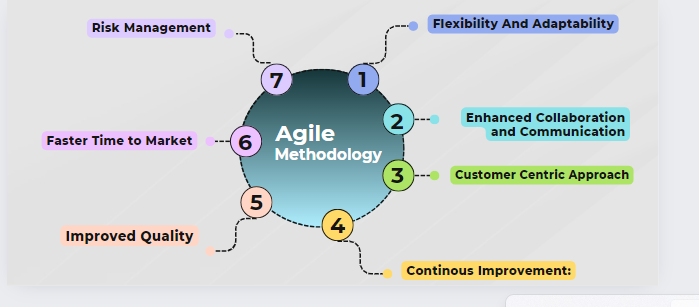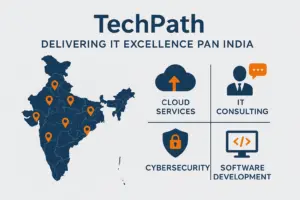
How Agile Methodology Boosts IT Project Success
- Date September 6, 2024
Introduction
Agile methodology has transformed IT project management, providing dynamic approach that increases success rates through adaptability, cooperation, and continual improvement. Unlike traditional approaches, Agile allows teams to adjust quickly to changes, prioritize client demands, and deliver value gradually. This flexibility not only eliminates risks, but also encourages innovation. It ensures that IT initiatives are aligned with business objectives and evolve in tandem with technical advances.
In today’s ever-changing technology landscape, IT initiatives face enormous struggles. These issues are frequently the result of quickly changing market needs, technological breakthroughs, and increasing client expectations. Traditional project management approaches, Waterfall, which take a linear and sequential approach, frequently fail to keep up with these developments. The inflexible framework of these approaches can result in project delays, cost overruns, or even complete failures.
This is where Agile methodologies come into play. Agile, with its repeated and increasing approach, has become a game changer in IT project management. Agile methodology, which emphasizes flexibility, collaboration, and customer-centricity, has greatly improved IT project success rates. But how precisely does Agile help IT projects succeed? Let’s go deeper into the main points.
Flexibility And Adaptability
One of the keys reasons because Agile methodology improves IT project success is its flexibility and adaptability. Unlike traditional project management systems, which necessitate comprehensive advance preparation and fight changes once the project is underway, Agile change. In an Agile setting, change is viewed as an opportunity to improve project and provide more value to the client.
Agile projects are organized into tiny, manageable iterations or sprints, which typically run for two to four weeks. At the end of each sprint, the team provides a potentially ship-able product increment. This repeated approach enables teams to incorporate feedback, address unexpected challenges, and modify project direction as needed. This flexibility is essential in the IT industry, where technology and market demands can shift rapidly.
Consider a software development project. The project may begin with a specific set of features in mind. As time goes on, user feedback may reveal the need for new or more functionality. In a traditional project management model, incorporating such changes would require significant rework, time, and money. However, in an Agile environment, the team can quickly adjust to these changes while maintaining the overall project timeline.
Enhanced Collaboration and Communication
Agile technique emphasizes collaboration and communication, both within the project team and with stakeholders. Traditional project management systems sometimes include lengthy planning phases followed by implementation, during which communication may be rare. This lack of communication can result in misunderstandings, misplaced expectations, and, eventually, project failure.
In contrast, Agile promotes ongoing communication among team members, stakeholders, and customers. In Agile projects, regular communication is facilitated by methods such as daily stand-up meetings and sprint reviews. These meetings ensure that everyone is on the same page. Any difficulties are resolved as soon as possible, and that the project remains on track to fulfill client expectations.
Furthermore, Agile promotes a collaborative work environment in which team members work closely together, typically in cross-functional groups. This collaboration allows team to use varied skill sets, information, and views, resulting in more unique solutions and better decision-making. Furthermore, incorporating customers and stakeholders throughout the project ensures that their feedback is constant. This results in a product that better fits their requirements.
Customer Centric Approach
Agile methodology is based on a customer-centric approach. Agile initiatives are intended to provide value to customers early and continually. This is accomplished by breaking down the project into smaller, more manageable pieces that are completed at the conclusion of each sprint. Each increment represents a potentially shippable product that may be inspected and tested by the customer.
This strategy keeps the consumer involved throughout the project, providing feedback and ensuring that the outcome meets their expectations. Agile decreases the risk of generating a product that fails to fulfill the needs or market demands of the consumer. It also allows customers to observe progress early on, which boosts their pleasure and confidence in the project.
Furthermore, Agile’s client-centric approach helps in the prioritization of additions and functions based on user feedback and market need. This means that the most valuable elements are produced first, ensuring that the project provides maximum value even if it must be cut short due to time or money restrictions.
Continous Improvement
Agile methodologies encourage a culture of continual improvement. At the end of each sprint, the team holds a thoughtful meeting to discuss what went well, what didn’t, and what could be changed for the next sprint. This method, known as the “Inspect and Adapt” principle, enables the team to continuously improve their processes, identify bottlenecks, and make changes.
Continuous improvement applies not only to the team’s operations, but also to the product itself. Delivering product increments at the end of each sprint allows the team to collect feedback from customers and stakeholders, identify areas for improvement, and implement changes in succeeding sprints. This iterative method ensures that the product improves over time, becoming more in line with client requirements and market trends.
Furthermore, ongoing development promotes a learning culture within the workforce. Team members are encouraged to try new things, take calculated risks, and learn from their errors. This promotes innovation and creativity, resulting in better ideas and successful initiatives.
 Risk Management in Agile
Risk Management in AgileRisk Management
Here’s a revised version of the sentence without consecutive sentences:
Risk management is an essential component of project management, and Agile methodology excels in this area. Traditional project management methods frequently include identifying problems early in the project and then adopting comfortable solutions. However, these solutions may become obsolete as the project proceeds and new hazards emerge.
In contrast, agile risk management takes a proactive approach. Agile decreases the likelihood of huge project failure by delivering small, incremental product releases and incorporating feedback continually. Any issues or hazards that develop during a sprint can be rapidly handled in the succeeding sprint, reducing their impact on the overall project.
Furthermore, Agile’s iterative nature enables teams to test and confirm assumptions early in the project cycle. For example, in a software development project, the team can create and test a minimal viable product (MVP) early on to validate critical assumptions about the product’s functionality and market demand. This lessens the risk of devoting significant time and money to a product that may fail in the market.
Agile also increases openness because the entire team participates in identifying and addressing risks. Regular meetings, such as sprint reviews allow teams to explore potential risks and build easy solutions together. This collaborative approach to risk management guarantees that hazards are identified and addressed quickly, lowering the possibility of project failure.
Faster Time to Market
In today’s competitive corporate world, the ability to provide items fast is a huge advantage. Agile methodology allows IT teams to bring products to market more quickly by focusing on providing small, incremental releases rather than waiting until the entire product is ready. This strategy enables businesses to respond faster to market changes, client needs, and competitive pressures.
Agile teams can produce working product increments at the conclusion of each sprint, allowing them to provide new features or upgrades to clients faster. This not only results in a faster return on investment, but also gives the organization a competitive advantage by being the first to market with new ideas.
Furthermore, shorter time to market helps businesses to receive customer input and make necessary changes to the product in following releases. This iterative approach guarantees that the final product is more closely aligned with consumer wants and market trends, improving the likelihood of success.
Improved Quality
Agile methodology emphasizes quality in both the product and the development processes. Continuous testing and integration are essential components of Agile, ensuring that errors are spotted and handled early in the development cycle. This proactive approach to quality control decreases the possibility of flaws being introduced into the final product, resulting in a higher-quality product.
Furthermore, Agile involves an excellence-oriented team culture. Agile teams strive to increase their work quality by emphasizing continuous improvement and assessing and modifying processes frequently. This devotion to quality not only results in superior products, but it also contributes to the project’s overall success.
Furthermore, Agile emphasizes customer feedback and participation, ensuring that the product fulfills the customer’s expectations and quality standards. By incorporating consumers in the testing and review process, Agile teams can discover and address quality concerns early on, lowering the risk of delivering a poor product.

Conclusion
Agile methodology has proven to be an effective strategy for increasing the success rate of IT projects. Its agility, flexibility, and customer-centric approach allow teams to respond rapidly to changes. This gives additional value, and continuously improve both the product and the procedures used to create it. Agile reduces risks, improves quality, and speeds up time to market by encouraging collaboration. It also improves communication and builds a culture of continuous improvement.
In an industry where technical breakthroughs and market demands are always changing, Agile provides the framework for successfully navigating these obstacles. By adopting Agile, IT teams can not only improve their project success rates, but also develop products that better satisfy customer expectations and drive corporate growth.
In conclusion, Agile methodology improves IT project performance by offering a flexible, collaborative, and customer-focused approach that is well-suited to the changing nature of the IT business. Its emphasis on continuous improvement, risk management, and quality assurance guarantees that projects are finished on schedule, within budget, and to the intended standard of quality. As the IT sector evolves, Agile will continue to be an important tool for managing the complexities and uncertainties of modern IT projects.
You may also like

TechPath: Delivering IT Excellence PAN India

Comprehensive IT Services by TechPath

